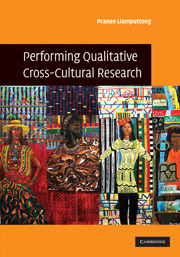Book contents
- Frontmatter
- Contents
- Preface
- About the author
- About the book
- 1 Performing qualitative cross-cultural research: an introduction
- 2 Moral and ethical perspectives
- 3 The research participants: accessing and reciprocity
- 4 Cultural sensitivity: a responsible researcher
- 5 Insider/Outsider perspectives and placing issues
- 6 Cross-cultural communication and language issues
- 7 Personal and collective testimony
- 8 Local knowledge, local power and collective action
- 9 Writing and disseminating in cross-cultural research
- In closing …
- References
- Index
- References
7 - Personal and collective testimony
Published online by Cambridge University Press: 05 June 2012
- Frontmatter
- Contents
- Preface
- About the author
- About the book
- 1 Performing qualitative cross-cultural research: an introduction
- 2 Moral and ethical perspectives
- 3 The research participants: accessing and reciprocity
- 4 Cultural sensitivity: a responsible researcher
- 5 Insider/Outsider perspectives and placing issues
- 6 Cross-cultural communication and language issues
- 7 Personal and collective testimony
- 8 Local knowledge, local power and collective action
- 9 Writing and disseminating in cross-cultural research
- In closing …
- References
- Index
- References
Summary
In listening to the stories of indigenous storytellers, we learn new ways of being moral and political in the social world. We come together in a shared agenda, with a shared imagination and a new language, struggling together to find liberating ways of interpreting and performing in the world. In this way, does research cease to be a dirty word?
(Denzin et al. 2008a: 15)By speaking collectively, women of color not only reclaim their humanity but, at the same time, empower themselves by making sense of their experience of vulnerability and subjugation.
(Madriz 2000: 843).Based on theoretical frameworks that I discussed in Chapter 1, I now introduce some qualitative methods in this chapter and the next. I make no claim that all qualitative methods will be appropriate in cross-cultural research. This is precisely what Esther Madriz (2000: 840) has suggested: ‘Some methodologies are more suitable than others for shattering a colonizing discourse in which images of research subjects as the Other are constantly reproduced’ (see also Fine 1994; Denzin et al. 2008a; Liamputtong 2008). Thus, I will focus only on those methods that will allow cross-cultural researchers to work more sensitively with the research participants. I shall, however, provide some useful reading materials for readers to consult further at the end of the chapter.
Oral/life history, according to Valerie Yow (2005: 3), ‘is the recording of personal testimony delivered in oral form’ (see also Benmayor 1991; Banks-Wallace 2002).
- Type
- Chapter
- Information
- Performing Qualitative Cross-Cultural Research , pp. 162 - 185Publisher: Cambridge University PressPrint publication year: 2010



